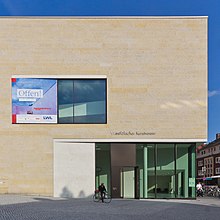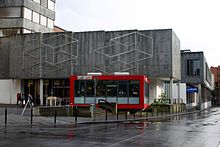Westphalian Art Association
The Westfälischer Kunstverein is a non-profit and registered association based in Münster , which is dedicated to the mediation of contemporary art . It is one of the oldest German art associations .
history
The Westphalian Art Association was founded in 1831 by citizens of the city of Münster for the purpose of “spreading the true sense of art and good taste recognized in artistic achievements as far as possible.” With initially 50 members, the art association organized exhibitions of contemporary artists, primarily from the regional environment. Until 1856 there was a higher drawing school founded by the association. The art association began collecting activities back then, which means that it now has a comprehensive inventory of medieval art.
The association's first exhibition took place in autumn 1832 in the auditorium of the Royal Theological and Philosophical Academy , where more than 200 works by artists from Münster were shown. In 1836 the association got its own exhibition room with the old town cellar, until the building was demolished in 1902. Up until now the existing exhibition space had already become too small. A solution was found in cooperation with the Antiquities Association for Westphalia. The latter contributed sufficient exhibition space with the Westphalian State Museum built in 1908 , but did not have a collection of works of art, while the Westphalian Art Association brought in the exhibits.
In the years that followed, the focus of the collection shifted towards international modern art. During the First World War , the events of the war dominated the activities and goals of the association. After the end of the war, the association ran out of finances, so that it had to auction its property. During the time of National Socialism , there were additional reprisals against the association: The association was subdivided into the Reich Chamber of Fine Arts and had to bow to the dictates of the political leadership with regard to the exhibitions. With the extensive destruction of the museum in 1944, activities had to be stopped again.
In 1946 the association and its managing directors resumed their activities. They devoted themselves to the modern avant-garde in exhibitions and gained national importance. As early as 1958, Peter Leo showed Josef Albers and in 1960 borrowed paintings by Vincent van Gogh and Piet Mondrian from the Stedelijk Museum in Amsterdam . His successor Dieter Honisch exhibited Ossip Zadkine and Ernst Wilhelm Nay in 1964 . He deepened the connection between the Kunstverein and Josef Albers when he encouraged him to do his first screen print in 1961. From the 1960s onwards, the focus shifted to contemporary art. In addition, the association intensified the purchase of contemporary works of art, which the public had already requested in the 1950s. Today, collecting and exhibiting is limited exclusively to contemporary art.
Exhibiting since 1972
With the large skylight hall by Max von Hausen behind the two overhead portals by Josef Albers above the main entrance on the upper floor of the new building of the Westphalian State Museum , the Kunstverein had its first own exhibition space from 1972 to 2009, which has been in the new building by Volker Staab an der Rothenburg is located.
From 1972 to 1978 the managing director Klaus Honnef pursued progressive projects with the exhibitions Arte Concreta , Konzept ist die Form , Lawrence Weiner , Sigmar Polke and Jörg Immendorff ; From 1978 to 1985 Thomas Deecke took over the management. During his tenure, the association celebrated its 150th anniversary in 1981 and had exhibitions such as Rebecca Horn , Der Eintänzer (1979), Languages beyond Poetry (1979), Roman Opalka (1981), Stephan Huber , Das Gottesreich fliegen: Der Kunstverein tanzt , Video art in Germany , Abraham David Christian , Der heilige Mensch, Alle Erde, Danzas contra la morte, Transit (1982).
Since 1985, the new director Marianne Stockebrand has resumed collecting activities with the acquisition of series of sheets by Sol LeWitt and Christa Näher, for example, or watercolors by Gerhard Richter . In a broad spectrum she showed Cindy Sherman (1985/86), Edward Ruscha (1986), Günther Förg (1986), sculptures by Katharina Fritsch (1989) and classical positions of minimalism . From 1990 the managing director Friedrich Meschede devoted himself to various approaches to installation art , among others in projects with Ulrich Görlich (1990/91), Hubert Kicol (1990/91), Jessica Stockholder and Ellsworth Kelly (1992).
The subsequent director Heinz Liesbrock exhibited the "Paper Collection" from the Kunstverein's collection for the first time (1996). He dedicated other projects to current trends in architecture : Rotterdam in the 20th Century: Utopia or Reality (1993) and the Bolles / Wilson architectural office (1993/94). He dedicated exhibitions of painting to artists such as Edward Hopper , Ad Reinhardt and Giorgio Morandi . In 1999 Susanne Gaensheimer took over the management. Her first project was Inside-Out , a group exhibition with works by Tilo Schulz , Apolonija Sustersic and Nathan Coley . In 2001 she showed Tobias Rehberger's Maserati Quattroporte . In order to intensify communication with the audience, artist talks and lectures were offered at all exhibitions. Parallel to the Real Places exhibition , the Where is the Center? instead of.
From 2001 to 2009 Carina Plath was the director of the art association. Among other things, she showed the exhibitions formal social (2002); Prisoners by Pawel Althamer (2002), Wilhelm Sasnal (2003), Valérie Favre (2004), Matthew Buckingham (2005); and T, O, U, C, H, I, N, G - Perception and Film (2005). The Westphalian Art Association was awarded the Prize for German Art Associations of the Arbeitsgemeinschaft Deutscher Kunstvereine (ADKV) at Art Cologne in 2008 . Plath moved to the Sprengel Museum Hannover , where she was curator for contemporary art and the collection of classical modernism.
Katja Schroeder took over the management from 2010 to 2012. She was already acting director of the Westphalian Art Association and previously worked as a curator at the Frankfurter Kunstverein . Kristina Scepanski has been the director of the Westphalian Art Association since January 2013. In addition to group exhibitions, Scepanski has so far shown individual shows by Liz Magic Laser, Virginia Overton, Peter Wächtler, Nicolas Party and Camille Henrot.
The Westphalian Art Association has 950 members who have numerous offers and discounts such as free entry, participation in excursions and the purchase of annual gifts. During the demolition and rebuilding of the Westphalian State Museum (since 2009), the Kunstverein did not have any permanent exhibition rooms and used different locations in Münster for its program of exhibitions and events. Although the State Museum only reopened in September 2014, the Westphalian Art Association moved its exhibition space in the new building of the State Museum an der Rothenburg in April 2013 and has thus returned to its original location in the center of Münster.
In addition to the exhibitions for contemporary art, the association organizes guided tours, lecture series, film programs, jazz concerts, symposia, art trips and other events. Every year it organizes three to five exhibitions that present and evaluate current developments in the visual arts. Accompanying catalogs provide more detailed information on individual artists or thematic contexts.
Web links
- Homepage of the Westphalian Art Association
- Christoph Behnke, On the founding history of German art associations, 2001 (p. 4) (PDF file; 50 kB)
- Interview with Carina Plath in: Magazin art 6/2008
- Change of management at the Westfälischer Kunstverein, in the art magazine on February 25, 2010
Coordinates: 51 ° 57 ′ 43 " N , 7 ° 37 ′ 30" E

